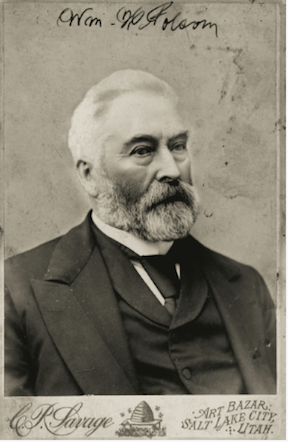William H. Folsom
William Harrison Folsom is best known for construction of historic buildings in Salt Lake City, Utah. Much of his work was commissioned by The Church of Jesus Christ of Latter-day Saints and he served for a time as the Church Architect.
Folsom was born on March 25, 1815, in Portsmouth, New Hampshire. Both sides of his family included carpenters and sawmill owners. He worked with his father in his contracting firm and later assisted his father in running a building business in Buffalo, New York, where they constructed the new city docks for the Erie Canal.[1]
Folsom and his wife, Zerviah Eliza Clark, were baptized in the icy Niagra River on February 17, 1842. In the spring of that year, they went to Nauvoo, Illinois, where he worked on the Nauvoo Temple until it was completed in May 1846. He was one of a few who remained for the completion and dedication of the temple.
He preached and campaigned in Ohio for Joseph Smith’s candidacy for president of the United States. He also fought in the Battle of Nauvoo.
Rather than depart for Winter Quarters, Folsom and his family lived with another Latter-day Saint family in a home in Farmington, Iowa.
- Early in 1847 while in Farmington by himself, he was surrounded by an unfriendly and intoxicated group of men. According to a much later account of the incident, the group recognized him as a Mormon, tied a rope around his neck, threw it over the awning of a store, and lifted him off his feet three times. The third time he was left hanging while the men retired into the store. He was saved when an acquaintance arrived on the scene and released him. Shortly after this experience, Folsom understandably moved his family to a safer location.[2]
He and his family lived in Keokuk, Iowa. From 1849 to 1851, he worked on water projects to help mine gold in Rough and Ready, California. He returned to his family and friends with $10,000 in cash and gold.
In 1854, he departed for Salt Lake City, but arrived in Council Bluffs, Iowa, too late to join the last company heading west. He stayed in Council Bluffs for six year and worked on such projects as the Nebraska Territory capitol building. He also served as branch president.
After arriving in Utah Territory in October 1860, he began working on church projects and was sustained as Church Architect in October 1861 where he served until 1867 when Truman O. Angell was able to return to the calling and Folsom continued as one of his assistants.
He was a planner for two construction firms. Some of his more notable projects include the Old Salt Lake Theater, the Salt Lake Tabernacle, the Salt Lake City Council Hall, the original ZCMI building (with Obed Taylor), the St. George Tabernacle (as consultant), and the Provo Tabernacle. He supervised the re-excavation of the Salt Lake Temple stonework after it had been buried with the approach of Johnston’s army in 1858. Folsom lived in Manti, Utah, until the Manti Utah Temple was completed. Two years after he returned to Salt Lake City, he was arrested for bigamy and sold his home in Manti to pay the fine.[3]
Folsom served two short-term missions for the Church to New York and other eastern states.
Folsom remarried in 1863 after the death of his first wife. Two years later he married a third time. He raised twenty-three children. He died on March 19, 1901.
